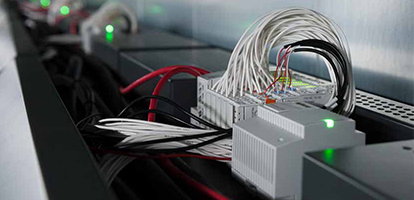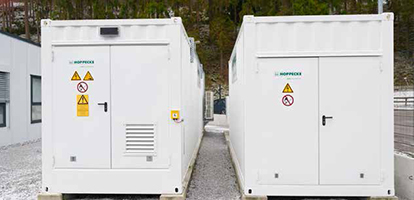



With a scalable hybrid energy storage system of lead acid and lithium ion batteries, the battery expert HOPPECKE from Brilon is allowing new flexibility in power supply.
Hardly a sound can be heard, only the air-conditioning fans turning slowly. It’s hard to believe that the within the inconspicuous container runs one of the most innovative and robust energy storage systems currently available on the market. “We have confirmed the feasibility of the systems, and our expectations have been exceeded,” says Matthias Büter, Product Manager and Project Director of HOPPECKE Batterien GmbH & CO. KG from Brilon.
Energy storage systems are playing an increasingly important role in meeting the challenges of the energy transition. They stabilize the power grid and support medium-sized and large industrial plants in absorbing the shock of their energy demand and saving on infrastructure investments.
Storage systems can do even more: They make it possible to optimize energy consumption even with self-produced wind or solar power, provide power for electric charging stations and ensure an uninterrupted power supply. “Our ‘sun | systemizer scalecube’ large storage system allows all these challenges to be met economically,” explains Büter.
Lead and Lithium in a Sensible Combination
The HOPPECKE innovation has an essential advantage: It is modularly scaleable, so it can be adapted to any application. The example on the plant premises can take in and discharge up to 1.5 megawatts of electric power. This power is divided among three battery units with a total energy content of about 2,600 kilowatt-hours: Two units consist of a total of two times 416 serially connected, maintenance-free lead cells from HOPPECKE of the grid|power VR M 2V 600Ah type.
Another battery unit has been implemented with 2,560 lithium ion cells that are connected into individual modules. “The lithium ion battery is the real workhorse for the application, since it is more cycle-proof than the two lead batteries. The lead units form the backup,” explains Büter. All the technology is housed in two containers that are specially protected against weather.
One standard-sized container accommodates the lithium unit and another, somewhat larger one the lead units. Within the containers, the batteries and accumulators are stacked neatly in specially developed racks. In order to be able use as many lead cells as possible and thus achieve the highest possible energy density of the area while taking up at little space as possible and meeting safety requirements, the two middle rack rows of the four total can be shifted electrically. This creates a 60 centimeter wide maintenance passageway between the two rows at the press of a button.
Data Backup with the Cloud
The hybrid system brings with it a valuable added benefit: “The storage system is able to provide temporary electricity as primary control power. The requirements for this are especially strict,” explains Büter. The full primary control power must be available within 30 seconds so fluctuations in the power grid can be compensated quickly.
For this purpose, it is necessary to make all network-relevant data available. This is the only way for all participants – the local network operator, the trader who sells the feed-in or feed-out power of the system to the electricity exchange and the HOPPECKE service department – to make optimal use of the power bank. “We met this challenge with the support of WAGO,” says Project Director Büter.
The result even goes a good bit beyond what is necessary. “The idea was to be able to query, not just the state of charge of the lead units, but each individual lead cell. We simply want to show what is possible,” says Büter. Furthermore, all cell voltages and temperatures are recorded in real time, and the historical data is stored in the WAGO Cloud Data Control. The essential advantage of the cloud solution is the possibility of site-independent access to the data.
Sensors, in connection with eight-channel analog input modules from WAGO (750-459), record the voltage and current values on each lead cell. A WAGO fieldbus coupler (750-532) that records the data is installed on each of the 52 racks. The 52 devices are connected to each other via Ethernet cables and pass the data on the the WAGO PFC200 controller through this channel.
“It was an immense advantage that we were able to use customized logic on the WAGO controller,” explains Büter, because HOPPECKE developed its own algorithm to determine the state of charge from the recorded voltage and current values and programmed this onto the controller. Besides the state of charge, the temperature is determined on every eighth lead cell. This too is handled by eight-channel input modules from WAGO (750-451). “All this together yields a monitoring system for lead batteries such as lithium ion batteries provide inherently as part of their battery management system,” explains Büter.
Energy Management with the PFC200
In the lithium unit, a PFC200 gets the required information on the state of charge, temperature and other relevant data directly from the battery management system of the batteries via their MODBUS interface. Another PFC200 monitors and controls the DC converter. In terms of performance, a single controller would suffice for the entire power bank.
The reason for equipping each section with its own controller is the modular concept. “For example, if customers don’t need the converter, we can simply omit it and sill know that the system’s communication concept will function reliably. The system’s power and energy content can also be customized,” explains Büter.
Finally, the fourth and final PFC200 serves as the central monitoring and control unit that receives all the data from the entire system. This also includes information on the air-conditioning with which the containers are equipped. The data is processed graphically and converted into a visualization. All participants – network operators, power traders and the local authorities – get all the necessary information sent to them in real time through innovative interface management or displayed in the visualization created by HOPPECKE. “The modular large battery storage system corresponds in every detail to our philosophy of offering the customer the perfect solution for every problem,” says Büter. The system may work quietly and inconspicuously, but it is hardly the runt of the litter.
Text: Andreas Grabosch, WAGO
Photo: Jens Sundeheim